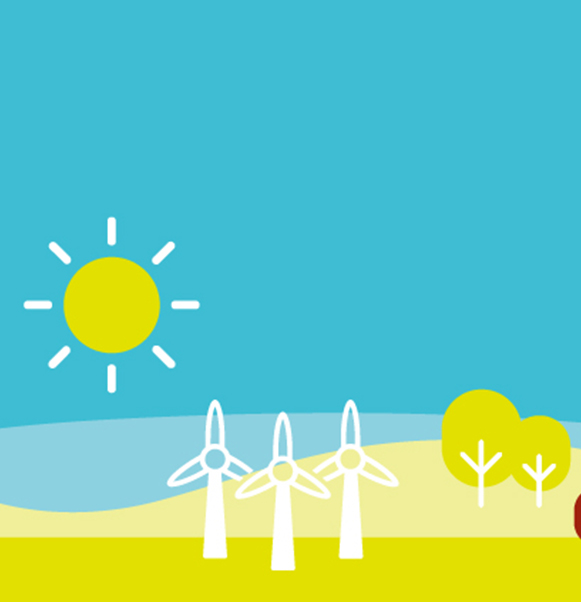

Our Green Glossary helps clear up carbon jargon
Our new Green Glossary helps clear up carbon jargon
Ever felt baffled by energy and environmental jargon? Well, you’re not alone. Our recent research1 found that almost two thirds (64%) of those we questioned say they want to take climate action but feel overwhelmed by the numbers or jargon or are put off by the lack of information available on the topic.
We also found that a similar number (62%) have bluffed their way through conversations about the environment with friends and family. Whilst only 10% of Brits know what COP26 – the key United Nations Climate Change Conference where world leaders will come together to discuss how best to respond to the climate emergency – actually is. And four in five (82%) would do more for the environment if they saw less carbon jargon and instead received simpler information about what they could do to reduce their impact on the planet.
Simplifying the language we use helps our customers to properly understand the benefits of a cleaner, greener and more sustainable lifestyle. Knowing more can be key to doing more, and we know so much can be achieved when we all do our bit.
So to help people better understand carbon jargon ahead of COP26, we’ve produced our Green Glossary, setting out in clear and simple language the meaning of 10 of these often misunderstood terms.


1. Greenhouse gases
A greenhouse gas is any gas released into the Earth's atmosphere that traps heat and contributes to climate change. The three main greenhouse gases are carbon dioxide, methane and nitrous oxide which all primarily come from the burning of fossil fuels (coal, oil and gas).
Carbon dioxide is the single largest contributor to greenhouse gases, mainly coming from power generation, transport (such as cars, planes and lorries) and heating our homes and businesses. Methane is more powerful than carbon dioxide when it comes to warming the Earth, and its sources include being released from landfills or livestock, such as cows.
2. Net zero
Net zero means creating an equal balance between the greenhouse gases we produce and the amount we remove from the atmosphere. This is done by changing our behaviour to produce less of the harmful gases in the first place, for example switching to renewable energy, while also actively removing the remaining greenhouse gases from the atmosphere, such as by planting more trees to absorb them.
The UK Government says we need to be net zero by 2050 and we can all play a role in helping to achieve this. Simple things we can all do include making your home more energy efficient to reduce the amount of energy your home uses and even generating your own renewable energy, for example from solar panels.


3. Carbon offsetting
Carbon offsetting provides a way to balance out carbon dioxide emissions and our impact on the planet.
This could be done by funding projects that reduce the carbon dioxide emissions generated or permanently remove the same amount of carbon dioxide from the atmosphere that you generate. One example of this is that when you take an international flight you might donate to a non-profit organisation that plants trees and supports re-wilding projects which absorb carbon dioxide. A mature tree, for example, can absorb around 22kg of carbon dioxide per year2.
Similarly, businesses can buy permits or carbon credits generated by projects that are cleaning up the atmosphere to compensate for the emissions they haven’t yet eliminated.
4. Carbon neutral
Companies, processes and products become carbon neutral when they calculate how much carbon dioxide has been emitted, and then offset these emissions via other means. The more we can do to minimise carbon dioxide emissions in the first place through behavioural change and new technologies, the less we have to rely on carbon offsetting projects to be carbon neutral.
5. Carbon negative and climate positive
Carbon negative and climate positive are interchangeable terms which mean the same thing. It’s going one step further than net zero and aiming to remove more carbon dioxide from the atmosphere than you emit through your day-to-day activities.


6. Carbon footprint
In short, a carbon footprint is a measurement of your impact on the planet. It’s the total amount of carbon dioxide that you as an individual, organisation or community releases into the atmosphere through your actions.
For example, the more you fly, drive or burn fossil fuels, the bigger your footprint, whilst the more you do to be more sustainable, such as walking or cycling instead of driving, using renewable electricity, and generally being more energy efficient, the smaller your carbon footprint will be.
7. CO2e (carbon dioxide equivalent)
Known as carbon dioxide equivalent, CO2e is the measurement we use for all greenhouse gas emissions rolled into one. It’s a simple way to describe every greenhouse gas in one single unit – helping us to easily understand and compare the environmental impact of different activities.
8. A tonne of carbon dioxide
It’s hard to know how to visualise one tonne of carbon dioxide but as an example each passenger on a return flight from London to New York is responsible, on average, for roughly one tonne of carbon dioxide3.
To put things into perspective, in 2020, the UK is estimated to have emitted 414.1 million tonnes of CO2e4, with each household emitting about 2.4 tonnes of carbon dioxide5.


9. Kilowatt hour (kWh) and megawatt hour (MWh)
In order to fully understand your energy use and where you might be able to make savings, you need to know how it’s measured.
A kilowatt hour (kWh) is the unit we use to measure energy in your home, and you may have seen this term on your energy bills. Simply put it’s the amount of energy you’d use if you kept a 1,000 watt appliance running for one hour.
A 10 watt energy saving light bulb running for 100 hours, or a 2,000 watt oven running for half an hour would both use 1 kWh of electricity.
And a megawatt hour (MWh) is 1,000 kWh.
10. Renewable energy
Renewable energy is power generated from natural resources that are quickly replenished, such as the sun (solar), wind (turbines) or water (hydroelectric dams) and it doesn’t contribute to climate change. What’s more, renewable energy is unlimited as the sun will keep shining, the wind will keep blowing and water will keep flowing.
Together, as E.ON across Europe, we’re taking #actionforclimate and reducing carbon emissions by more than 99 million tonnes a year6. In the UK, we’re helping to make our customers’ homes, businesses and communities more sustainable, so we can all take action for the climate, together.
You can download our full Green Glossary here.
1. Research carried out by Ginger Comms on behalf of E.ON in October 2021 with 1,500 respondents
2. Office for National Statistics: Covid-19 restrictions cut household emissions
3. The Guardian: How your flight emits as much CO2 as many people do in a year
4. BEIS: 2020 UK greenhouse gas emissions, provisional figures
5. Calculated by taking total UK residential carbon dioxide emissions in 2020 (source as point 4 above) and dividing it by the number of UK households in 2020 (source: Office for National Statistics - Families)
6. Saving based on the avoided CO2 emissions from renewables assets and projects connected to E.ON's network across Europe when compared to the average CO2 levels emitted by non-renewable generation


Our blog
Read our latest blogs to discover how E.ON is leading the energy transition through smart and sustainable solutions.


10 ways to reduce your carbon footprint
From small tweaks to your daily routine to bigger lifestyle changes, there are many ways to reduce your carbon emissions and achieve a low carbon footprint.


Our sustainability and solutions jargon buster
Sustainability jargon can sometimes be difficult to understand so we’ve pulled together a helpful glossary of sustainability terms to help you make sense of it all.
